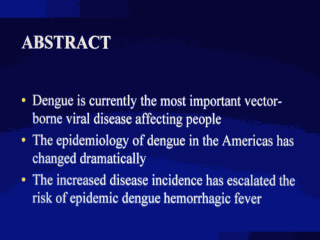Search inside of Supercourse and lectures in HTML and PPT format
|
|
|
|
front |1 |2 |3 |4 |5 |6 |7 |8 |9 |10 |11 |12 |13 |14 |15 |16 |17 |18 |19 |20 |21 |22 |23 |24 |25 |review |
 |
Dengue is currently the most important vector-borne viral disease affecting people, in terms of both morbidity and mortality. Repeated epidemics of dengue and dengue hemorrhagic fever afflicting millions of individuals occur annually in tropical and subtropical areas of the world inhabited by the
Aedes aegypti mosquito, the principal mosquito vector of dengue virus. A highly domesticated urban species, the
Aedes aegypti mosquito has become adapted to living in intimate association with humans and has a worldwide distribution in the tropics including the southeastern and southern border areas of the United States. Moreover, the ongoing resurgence of
Aedes aegypti in Mexico - fomented by increased air travel, urbanization, and poor mosquito control - has led to hyperendemicity, more frequent dengue epidemics, and the emergence of dengue hemorrhagic fever/dengue shock syndrome. Accordingly, the main purpose of this lecture is to identify and address the dominating factors influencing the resurgence of dengue fever along the U.S.-Mexico border. The lecture also will depict an arguable approach to dengue surveillance as well as describe existing efforts to prevent, control, and eradicate dengue (Aedes aegypti) with the aim of detailing potential problems that must be addressed to prevent further dengue fever outbreaks. Effective prevention and control programs will depend on improved surveillance designed to provide early warning of dengue epidemics. Virologic surveillance should be consider the most important element in any such early warning system. Dengue virus transmission should be monitored to determine which serotypes are present, their distribution, and the type of illnesses associated with each. Effective dengue surveillance can provide an early warning capability permitting emergency mosquito control measures to be implemented and major epidemics to be averted The term “Dengue” was first coined and used in Zanzibar in 1727. In 1780, an outbreak of dengue appeared in Philadelphia and a physician recorded dengue fever as “ breakbone fever “. This description is now generally accepted as the first clinical description of dengue. |